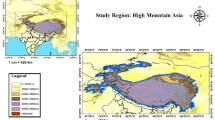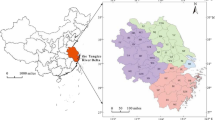Abstract
The lake-breeze at Taihu Lake generates a different specific heat capacity between the water body and the surrounding land. Taihu Lake has a significant impact on the atmospheric conditions and the air quality in the Yangtze River Delta. This phenomenon is referred to as the Taihu Lake effect. In this study, two simulations were conducted to determine the impact of the Taihu Lake effect in the reference experiment (R-E) and sensitivity experiments (NO_TH). The control simulations demonstrated that the meteorological field and the spatial distribution of ozone (O3) concentrations over Taihu lake obviously changed once the land-use type of water body was substituted by cropland. The surface temperature of Taihu Lake was reduced under the impact of Taihu Lake, and a huge temperature difference caused a strong lake-breeze effect. The results also showed that the difference in the average concentrations of O3 between the R-E and NO TH experiments reached 12 ppbv in most areas of Taihu Lake, all day, on 20 May 2014. During daytime (0800–1600 LST, LST=UTC+8), the influence of the Taihu Lake effect on O3 in the Suzhou region was not significant. However, the influence of the Taihu Lake effect on O3 in the Suzhou region was obvious during nighttime (1800–2400 LST). The larger changes in the physical and chemical processes were horizontal and vertical advections under the influence of the Taihu Lake effect in Taihu Lake.
Similar content being viewed by others
References
Chameides, W., and J. C. G. Walker, 1973: A photochemical theory of tropospheric ozone. J. Geophys. Res., 78(36), 8751–8760.
Chen, F., and J. Dudhia, 2001: Coupling an advanced land surface–hydrology model with the Penn State- NCAR MM5 modeling system. Part I: Model implementation and sensitivity. Mon. Wea. Rev., 129(4), 569–585.
Chung, Y. S., 1977: Ground-level ozone and regional transport of air pollutants. J. Appl. Meteor., 16(11), 1127–1136.
Emmons, L. K., and Coauthors, 2010: Description and evaluation of the model for ozone and related chemical tracers, version 4 (mozart-4). Geoscientific Model Development, 3(1), 43–67.
Grell, G. A., S. E. Peckhama, R. Schmitzc, S. A. McKeenb, G. Frostb, W. C. Skamarockd, and B. Edere, 2005: Fully coupled “online” chemistry within the WRF model. Atmos. Environ., 39(37), 6957–6975.
Han, M., X. Q. Lu, C. S. Zhao, L. Ran, and S. Q. Han, 2015: Characterization and source apportionment of volatile organic compounds in Urban and Suburban Tianjin, China. Adv. Atmos. Sci., 32, 439–444, doi: 10.1007/s00376-014-4077-4.
Huang, C., and Coauthors, 2011: Emission inventory of anthropogenic air pollutants and VOC species in the Yangtze River Delta region, China. Atmos. Chem. Phys., 11(9), 4105–4120.
Huang, J. P., J. C. H. Fung, A. K. H. Lau, and Y. Qin, 2005: Numerical simulation and process analysis of typhoon-related ozone episodes in Hong Kong. J. Geophys. Res., 110(D5), D05301, doi: 10.1029/2004JD004914.
Jiang, F., T. J. Wang, T. T. Wang, M. Xie, and H. Zhao, 2008: Numerical modeling of a continuous photochemical pollution episode in Hong Kong using WRF–chem. Atmos. Environ., 42(38), 8717–8727.
Levy, I., and Coauthors, 2010: Unraveling the complex local-scale flows influencing ozone patterns in the southern Great Lakes of North America. Atmos. Chem. Phys., 10(22), 10 895–10 915.
Li, L., and Coauthors, 2012: Process analysis of regional ozone formation over the Yangtze River Delta, China using the community multi-scale air quality modeling system. Atmos. Chem. Phys., 12(22), 10 971–10 987.
Lin, Y. L., R. D. Farley, and H. D. Orville, 1983: Bulk parameterization of the snow field in a cloud model. J. Appl. Meteor., 22(6), 1065–1092.
Ling, Z. H., H. Guo, H. R. Cheng, and Y. F. Yu, 2011: Sources of ambient volatile organic compounds and their contributions to photochemical ozone formation at a site in the Pearl River Delta, southern China. Environmental Pollution, 159(10), 2310–2319.
Logan, J. A., 1985: Tropospheric ozone: seasonal behavior, trends, and anthropogenic influence. J. Geophys. Res., 90, 10 463–10 482.
Lyons, W. A., and H. S. Cole, 1976: Photochemical oxidant transport: Mesoscale lake breeze and synoptic-scale aspects. J. Appl. Meteor., 15, 733–743.
Oltmans, S. J., 1981: Surface ozone measurements in clean air. J. Geophys. Res., 86, 1174–1180.
O’Nell, S. M., and Coauthors, 2006: Modeling ozone and aerosol formation and transport in the Pacific Northwest with the community multi-scale air quality (CMAQ) modeling system. Environ. Sci. Technol., 40, 1286–1299.
Peckam, S. E., G. A. Grell, S. A. McKeen, and R. Ahmadov, 2013: WRF/Chem Version 3.5 User’s Guide. NOAA Earth System Research Laboratory, Colorado, USA.
Qu, Y., J. L. An, J. Li, Y. Chen, Y. Li, X. G. Liu, and M. Hu, 2014: Effects of NO x and VOCs from five emission sources on summer surface O3 over the Beijing–Tianjin–Hebei Region. Adv. Atmos. Sci., 31(4), 787–800, doi: 10.1007/s00376-013-3132-x.
Shang, L., Y. Liu, W. S. Tian, and Y. L. Zhang, 2015: Effect of methane emission increases in east Asia on atmospheric circulation and ozone. Adv. Atmos. Sci., 32(12), 1617–1627, doi: 10.1007/s00376-015-5028-4.
Stockwell, W. R., P. Middleton, J. S. Chang, and X. Y. Tang, 1990: The second generation regional acid deposition model chemical mechanism for regional air quality modeling. J. Geophys. Res. 95, 16 343–16 367
Tie, X., and Coauthors, 2013: Megacity impacts on regional ozone formation: Observations and WRF-Chem modeling for the MIRAGE-Shanghai field campaign. Atmos. Chem. Phys., 13(11), 5655–5669.
Vingarzan, R., 2004: A review of surface ozone background levels and trends. Atmos. Environ., 38(21), 3431–3442.
Zhu, B., H. Q. Kang, T. Zhu, J. F. Su, X. W. Hou, and J. H. Gao, 2015: Impact of Shanghai Urban land surface forcing on downstream city ozone chemistry. J. Geophys. Res., 120, 4340–4351.
Acknowledgements
This work was supported by the National Key Research and Development Program of China (Grant No. 2016YFA0602003) and the National Natural Science Foundation of China (Grant No. 91544229).
Author information
Authors and Affiliations
Corresponding author
Rights and permissions
About this article
Cite this article
Zhang, L., Zhu, B., Gao, J. et al. Impact of Taihu Lake on city ozone in the Yangtze River Delta. Adv. Atmos. Sci. 34, 226–234 (2017). https://doi.org/10.1007/s00376-016-6099-6
Received:
Revised:
Accepted:
Published:
Issue Date:
DOI: https://doi.org/10.1007/s00376-016-6099-6




